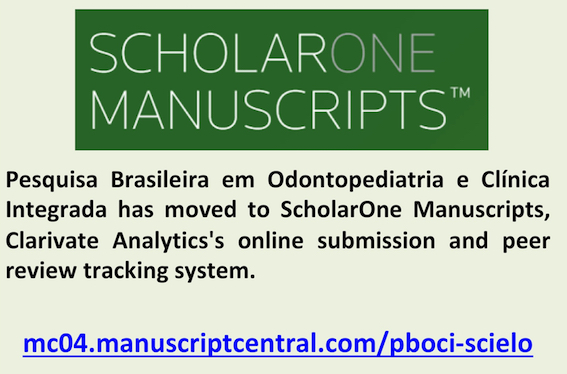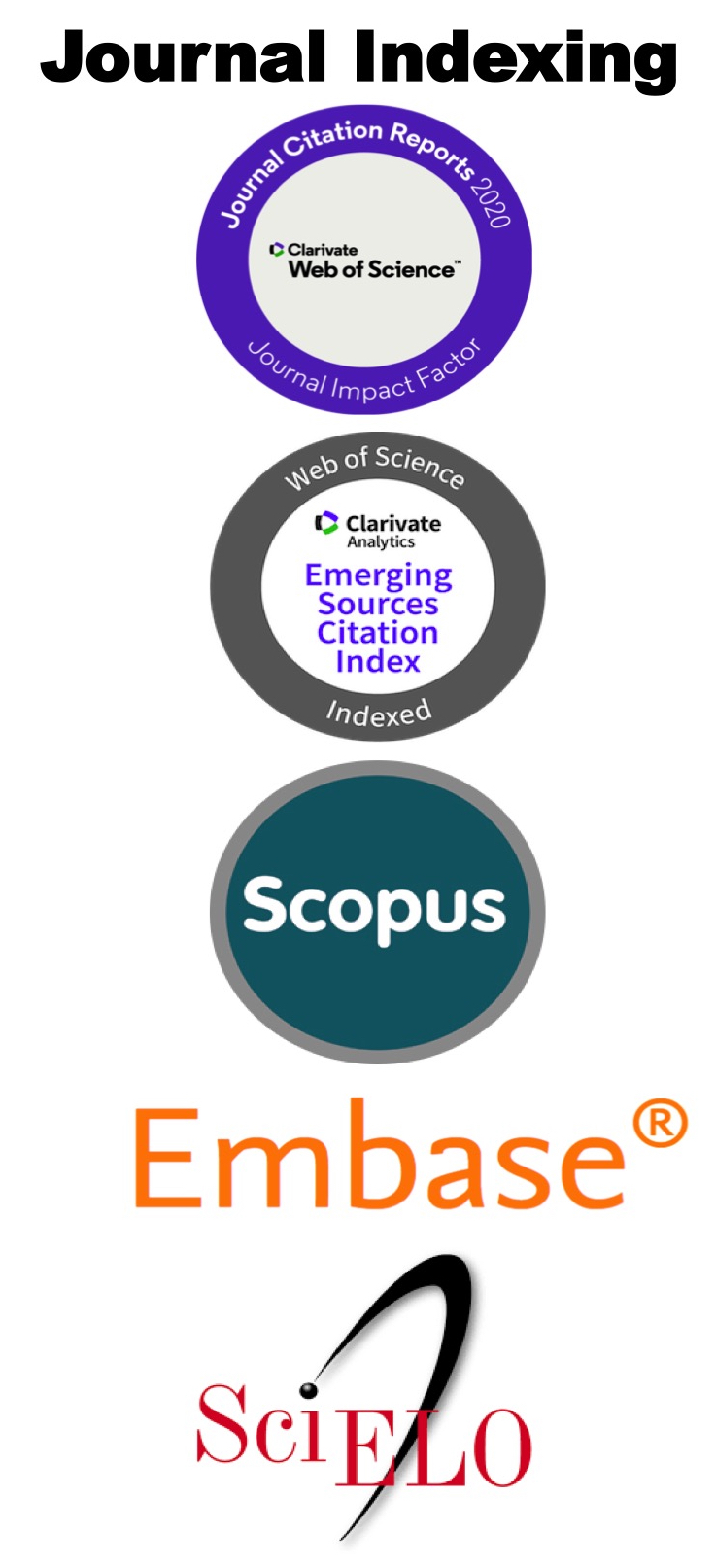Consumption of Cariogenic Ultra-processed Foods and Maternal Report of Dental Caries and Dental Pain among Preschool Children
Keywords:
Food, Processed, Dental Caries, Toothache, Observational Study, ChildAbstract
Objective: To assess the association between cariogenic ultra-processed foods (UPF) consumption and maternal reports of dental caries and dental pain among preschool children. Material and Methods: This cross-sectional study included 505 mothers of children aged 3 to 5 years enrolled in the Municipal Public School System in a large southern Brazilian city (Curitiba, Paraná). Socioeconomic data, maternal reports on dental caries and dental pain among children, and frequency of consumption of cariogenic UPFs among those children were collected. Univariate and multivariate Poisson regression analyses with robust variance were used for the data analysis (α=0.05) and presented in prevalence ratio (PR) and 95% confidence interval (95% CI). Results: The presence of dental caries and dental pain among children in the upper tercile of consumption of cariogenic UPFs was, respectively, 11.6% (95%CI:1.028-1.213) and 8% (95%CI:1.001-1.165) higher than that in the lower tercile. Dental caries and dental pain increased, respectively, by 12% (95%CI:1.074-1.169) and 10.3% (95%CI:1.060-1.149) for each year of the child. Moreover, a higher household income was a protective factor for dental caries (PRa:0.978; 95%CI:0.959-0.997) and for dental pain as well (PRa:0.977; 95%CI:0.958-0.997) among the children. Conclusion: A higher consumption of cariogenic ultra-processed foods (UPFs) was found to be associated with maternal reports of dental caries and dental pain among preschool children.References
Peres MA, Macpherson LMD, Weyant RJ, Daly B, Venturelli R, Mathur MR, et al. Oral diseases: A global public health challenge. Lancet 2019; 394(10194):249-260. https://doi.org/10.1016/S0140-6736(19)31146-8
Qin XF, Zi H, Zeng XJ. Changes in the global burden of untreated dental caries from 1990 to 2019: A systematic analysis for the Global Burden of Disease study. Heliyon 2022; 8(9):e10714. https://doi.org/10.1016/j.heliyon.2022.e10714
Paredes SDO, da Nóbrega RF, Soares TDS, Bezerra MED, de Abreu MHNG, Forte FDS. Dental pain associated with untreated dental caries and sociodemographic factors in 5-year-old children. J Clin Exp Dent 2021; 13(6):552-557. https://doi.org/10.4317/jced.57827
Zaror C, Matamala‐Santander A, Ferrer M, Rivera‐Mendoza F, Espinoza‐Espinoza G, Martínez‐Zapata MJ. Impact of early childhood caries on oral health‐related quality of life: A systematic review and meta‐analysis. Int J Dent Hyg 2022; 20(1):120-135. https://doi.org/10.1111/idh.12494
Gomes MC, Clementino MA, Pinto-Sarmento TCDA, Martins CC, Granville-Garcia AF, Paiva SM. Association between parental guilt and oral health problems in preschool children: A hierarchical approach. BMC Public Health 2014; 14:854. https://doi.org/10.1186/1471-2458-14-854
Ramos BLM, Umemura AMB, Bruni O, de Souza JF, Menezes JVNB. Parental report of dental pain and discomfort in preschool children is associated with sleep disorders: A cross-sectional study in Brazilian families. Eur Arch Paediatr Dent 2023; 24(1):43-53. https://doi.org/10.1007/s40368-022-00747-1
Karki S, Päkkilä J, Laitala M, Humagain M, Anttonen V. Influence of dental caries on oral health‐related quality of life, school absenteeism and school performance among Nepalese schoolchildren. Community Dent Oral Epidemiol 2019; 47(6):461-469. https://doi.org/10.1111/cdoe.12485
Sheiham A, James WP. Diet and dental caries: The pivotal role of free sugars reemphasized. J Dent Res 2015; 94(10):1341-1347. https://doi.org/10.1177/0022034515590377
Organización Panamericana de la Salud. Alimentos y bebidas ultraprocesados en América Latina: Ventas, fuentes, perfiles de nutrientes e implicaciones. Washington, D.C.: OPS; 2019. [In Spanish].
Araújo SMP, da Silva GQTL, Costa EL, Nunes AMM, Ribeiro CCC. Pathways in the association between added sugar consumption, obesity in mother‐child dyads, and chronic oral disease burden in early childhood. Eur J Oral Sci 2022; 130(2):e12847. https://doi.org/10.1111/eos.12847
Machado PP, Steele EM, Louzada ML da C, Levy RB, Rangan A, Woods J, et al. Ultra-processed food consumption drives excessive free sugar intake among all age groups in Australia. Eur J Nutr 2020; 59(6):2783-2792. https://doi.org/10.1007/s00394-019-02125-y
Monteiro CA, Cannon G, Lawrence M, Laura Da Costa Louzada M, Machado PP. Ultra-processed foods, diet quality, and health using the NOVA classification system. Rome, FAO; 2019.
Leme ACB, Fisberg RM, Thompson D, Philippi ST, Nicklas T, Baranowski T. Brazilian children’s dietary intake in relation to Brazil’s new nutrition guidelines: A systematic review. Curr Nutr Rep 2019; 8(2):145-166. https://doi.org/10.1007/s13668-019-0261-6
Da Costa Louzada ML, Dos Santos Costa C, Souza TN, Da Cruz GL, Levy RB, Monteiro CA. Impact of the consumption of ultra-processed foods on children, adolescents and adults’ health: Scope review. Cad Saude Publica 2022; 37(Suppl 1):e00323020. https://doi.org/10.1590/0102-311X00323020
De Souza MS, Vaz JDS, Martins-Silva T, Bomfim RA, Cascaes AM. Ultra-processed foods and early childhood caries in 0-3-year-olds enrolled at Primary Healthcare Centers in Southern Brazil. Public Health Nutr 2021; 24(11):3322-3330. https://doi.org/10.1017/S1368980020002839
Monteiro CA, Levy RB, Claro RM, Castro IRR de, Cannon G. A new classification of foods based on the extent and purpose of their processing. Cad Saude Publica 2010; 26(11):2039-2049. https://doi.org/10.1590/s0102-311x2010001100005
Monteiro CA, Cannon G, Levy RB, Moubarac JC, Louzada MLC, Rauber F, et al. Ultra-processed foods: What they are and how to identify them. Public Health Nutr 2019; 22(5):936-941. https://doi.org/10.1017/S1368980018003762
Bidinotto AB, Martinez‐Steele E, Cunha‐Cruz J, Thomson WM, Hugo FN, Hilgert JB. Food processing and its association with dental caries: Data from NHANES 2011‐2014. Community Dent Oral Epidemiol 2021; 49(6):565-573. https://doi.org/10.1111/cdoe.1262
da Silva NRJ, de Camargo MBJ, dos Vaz JS, Correa MB, Matijasevich A, da Silva dos Santos I, et al. Ultra‐processed food consumption and dental caries in adolescents from the 2004 Pelotas Birth Cohort study. Community Dent Oral Epidemiol 2023; 51(6):1180-1116. https://doi.org/10.1111/cdoe.12851
Cascaes AM, Da Silva NRJ, Fernandez MDS, Bomfim RA, Vaz JDS. Ultra-processed food consumption and dental caries in children and adolescents: A systematic review and meta-analysis. Br J Nutr 2022; 1-10. https://doi.org/10.1017/S0007114522002409
von Elm E, Altman DG, Egger M, Pocock SJ, Gøtzsche PC, Vandenbroucke JP. The Strengthening the Reporting of Observational Studies in Epidemiology (STROBE) statement: Guidelines for reporting observational studies. Lancet 2007; 370(9596):1453-1457.
Instituto Paranaense de Desenvolvimento Econômico e Social. Caderno estatístico município de Curitiba. 2019. Available from: http://www.ipardes.gov.br/cadernos/MontaCadPdf1.php?Municipio=80000 [Accessed on September 5, 2024]. [In Portuguese].
Fernandes IB, Sá-Pinto AC, Silva Marques L, Ramos-Jorge J, Ramos-Jorge ML. Maternal identification of dental caries lesions in their children aged 1–3 years. Eur Arch Paediatr Dent 2017; 18(3):197-202. https://doi.org/10.1007/s40368-017-0286-8
Boeira GF, Correa MB, Peres KG, Peres MA, Santos IS, Matijasevich A, et al. Caries is the main cause for dental pain in childhood: Findings from a birth cohort. Caries Res 2012; 46(5):488-495. https://doi.org/10.1159/000339491
Crema AF de A, Menoncin BLV, Crispim SP, Fraiz FC. Factors associated with the intake of ultra-processed cariogenic foods by preschoolers during the COVID-19 pandemic. Pesqui Bras Odontopediatria Clin Integr 2023; 23:e220080. https://doi.org/10.1590/pboci.2023.017
Textor J, van der Zander B, Gilthorpe MS, Liśkiewicz M, Ellison GT. Robust causal inference using directed acyclic graphs: The R package “dagitty.” Int J Epidemiol 2016; 45(6):1887-1894. https://doi.org/10.1093/ije/dyw341
Barreto KA, Colares V. The social status associated with dental experience among Brazilian children. Cien Saude Colet 2020; 25(10):3913-3919. https://doi.org/10.1590/1413-812320202510.32312018
Bastos JL, Peres MA, Peres KG, Araujo CLP, Menezes AMB. Toothache prevalence and associated factors: A life course study from birth to age 12 yr. Eur J Oral Sci 2008; 116(5):458-466. https://doi.org/10.1111/j.1600-0722.2008.00566.x
Yousaf M, Aslam T, Saeed S, Sarfraz A, Sarfraz Z, Cherrez-Ojeda I. Individual, family, and socioeconomic contributors to dental caries in children from low- and middle-income countries. Int J Environ Res Public Health 2022; 19(12):7114. https://doi.org/10.3390/ijerph19127114
Walton J, Bell H, Re R, Nugent AP. Current perspectives on global sugar consumption: Definitions, recommendations, population intakes, challenges and future direction. Nutr Res Rev 2023; 36(1):1-22. https://doi.org/10.1017/S095442242100024X
Hamner HC, Dooyema CA, Blanck HM, Flores-Ayala R, Jones JR, Ghandour RM, et al. Fruit, vegetable, and sugar-sweetened beverage intake among young children, by state-United States, 2021. MMWR Morb Mortal Wkly Rep 2023; 72(7):165-170. https://doi.org/10.15585/mmwr.mm7207a1
Huang Y, Chen Z, Chen B, Li J, Yuan X, Li J, et al. Dietary sugar consumption and health: Umbrella review. BMJ 2023; 381:e071609. https://doi.org/10.1136/bmj-2022-071609
Hajishafiee M, Kapellas K, Listl S, Pattamatta M, Gkekas A, Moynihan P. Effect of sugar-sweetened beverage taxation on sugars intake and dental caries: An umbrella review of a global perspective. BMC Public Health 2023; 23(1):986. https://doi.org/10.1186/s12889-023-15884-5
Ashraf R, Duncan AM, Darlington G, Buchholz AC, Haines J, Ma DWL, et al. The degree of food processing contributes to sugar intakes in families with preschool-aged children. Clin Nutr ESPEN 2024; 59:37-47. https://doi.org/10.1016/j.clnesp.2023.11.010
Vale GC, Tabchoury CPM, Arthur RA, Del Bel Cury AA, Paes Leme AF, Cury JA. Temporal relationship between sucrose-associated changes in dental biofilm composition and enamel demineralization. Caries Res 2007; 41(5):406-412. https://doi.org/10.1159/000105764
Lembacher S, Hofer V, Bekes K. The impact of dental pain on the oral health-related quality of life (OHRQoL) of preschool children in Austria. J Clin Med 2023; 12(18):5906. https://doi.org/10.3390/jcm12185906
Souto‐Souza D, Ramos‐Jorge ML, Oliveira TF, Soares ME da C, Primo‐Miranda EF, Pereira LJ, et al. Children who have more toothache‐related behaviors have worse masticatory performance. J Texture Stud 2022; 53(1):52-59. https://doi.org/10.1111/jtxs.12647
Quadri MFA, Ahmad B. Elucidating the impact of dental caries, pain and treatment on academic performance in children. Int J Paediatr Dent 2023; 33(4):394-408. https://doi.org/10.1111/ipd.13060
Darley RM, Karam SA, Dos Santos Costa F, Correa MB, Demarco FF. Association between dental pain, use of dental services and school absenteeism: 2015 National School Health Survey, Brazil. Epidemiol Serv Saude 2021; 30(1):e2020108. https://doi.org/10.1590/S1679-49742021000100011
Casamassimo PS, Thikkurissy S, Edelstein BL, Maiorini E. Beyond the dmft. JADA 2009; 140(6):650-657.
Gao X, Ding M, Xu M, Wu H, Zhang C, Wang X, et al. Utilization of dental services and associated factors among preschool children in China. BMC Oral Health 2020; 20(1):9. https://doi.org/10.1186/s12903-019-0996-x
Pentapati KC, Yeturu SK, Siddiq H. Global and regional estimates of dental pain among children and adolescents—Systematic review and meta-analysis. Eur Arch Paediatr Dent 2021; 22(1):1-12. https://doi.org/10.1007/s40368-020-00545-7
Fontana M, Santiago E, Eckert GJ, Ferreira-Zandona AG. Risk factors of caries progression in a Hispanic school-aged population. J Dent Res 2011; 90(10):1189-1196. https://doi.org/10.1177/002203451141392
Santos PS, Barasuol JC, Moccelini BS, Magno MB, Bolan M, Martins-Junior PA, et al. Prevalence of toothache and associated factors in children and adolescents: A systematic review and meta-analysis. Clin Oral Investig 2022; 26(2):1105-1119. https://doi.org/10.1007/s00784-021-04255-2
Lima LJS, da Consolação Soares ME, Moreira LV, Ramos-Jorge J, Ramos-Jorge ML, Marques LS, et al. Family income modifies the association between frequent sugar intake and dental caries. Int J Paediatr Dent 2023; 33(6):535-542. https://doi.org/10.1111/ipd.1305
Santin GC, Pintarelli TP, Fraiz FC, De Oliveira ACB, Paiva SM, Ferreira FM. ssociation between untreated dental caries and household food insecurity in schoolchildren. Ciencia e Saude Coletiva 2016; 21(2):573-584. https://doi.org/10.1590/1413-81232015212.00022015
Jones KE, Simancas-Pallares MA, Ginnis J, Shrestha P, Divaris K. Guardians’ self-reported fair/poor oral health is associated with their young children’s fair/poor oral health and clinically determined dental caries experience. Int J Environ Res Public Health 2023; 20(1):632. https://doi.org/10.3390/ijerph20010632
Snell AK, Burgette JM, Weyant RJ, Crout RJ, McNeil DW, Foxman B, et al. Association between a child’s caries experience and the mother’s perception of her child’s oral health status. J Am Dent Assoc 2019; 150(6):540-548. https://doi.org/10.1016/j.adaj.2019.01.032
Folayan MO, Alimi P, Alade MO, Tantawi M El, Adeniyi AA, Finlayson TL. Validation of maternal report of early childhood caries status in Ile-Ife, Nigeria. BMC Oral Health 2020; 20(1):336. https://doi.org/10.1186/s12903-020-01288-z
Brasil. Ministério da Saúde-MS Agência Nacional de Vigilância Sanitária-ANVISA. 2020. Available from: https://antigo.anvisa.gov.br/documents/10181/3882585/RDC_429_2020_.pdf [Accessed on August 25, 2024]. [In Portuguese].
Downloads
Published
How to Cite
Issue
Section
License
Copyright (c) 2024 Pesquisa Brasileira em Odontopediatria e Clínica Integrada

This work is licensed under a Creative Commons Attribution-NonCommercial 4.0 International License.



